Video surveillance has gotten a great attention as highly active application-oriented research area in computer vision, artificial intelligence, and image processing.
In this article, improving the quality of images obtained from surveillance cameras is implemented. Matrix filters and frequency filter and their principle of operation are described. Some methods are improved by their realization.
To understand how effective an algorithm of enhancement is, the quality of the processed images is evaluated. Firstly, we estimate the effectiveness of suggested removing noise filters and compare the calculated values with such filters as Filter2, Median, and Wiener.
Lately, we estimate filtered images’ contrast to see the frequency filter work.
Key words: surveillance system, image enhancement, noise reduction, estimation of filter effectiveness
Literature review
Video surveillance systems never stop their development. Engineers keep developing intelligent surveillance systems, distributed surveillance systems or automatized video processing ones etc.
As the examples of image processing in surveillance systems we should mention the fact the image processing could be used for helping in counting and classifying the vehicles and organizing a better traffic surveillance [1], the improvement of transport safety at level crossings (LC) [2], face recognition with surveillance cameras [3], investigation [4], evaluating moving objects in far field’s surveillance systems [5], a definition of the number of vehicles [6].
Numerous and different denoising methods of algorithms have already been proposed during the past few decades. Image enhancement can improve many spheres of our life.
Filters like Mean, Unsharp, Gaussian, Median, and Weiner are used to remove Salt and Pepper noise, Gaussian and Poisson noises. To examine the performance the Root Mean Square Error (RMSE), Mean Square Error (MSE) and Poison Signal-to-Noise Ratio (PSNR) suit [7]. The Standard Median Filter (SMF) is good for filtering Salt and Pepper noise with less than 40 % density noise [8].
The search for effective methods for image denoising is still an actual problem at the crossing of functional statistics and analysis. In despite of the sophistication of the proposed methods during recent time, many algorithms yet have not reached a desirable level of application. Some show a great performance when the image model matches to the algorithm assumptions but fail in common and make artifacts or remove fine structures of the image.
1 Introduction
The effectiveness of video monitoring of transport systems depends on many different factors. There is a list of circumstances that create many difficulties in their work. So the efficiency is significantly influenced by difficult weather conditions. The work of video cameras is complicated by changing ambient temperature and lighting, atmospheric precipitation, low illumination, as well as very high illumination on a sunny day.
Image enhancement will help to see the details on the obtained images, recognize objects, numbers, texts, faces etc.
The main reasons that reduce the quality of images: technical luminance noise of interference character; insufficient or excessive illumination of objects of shooting; lack of sharpness when getting an image; too small details that need to be discerned.
Algorithms for improving the images quality stored in raster graphic formats are becoming more widespread. This is connected to the developing of new methods and technical means of obtaining, transmitting and reproducing images. Image processing algorithms, basically, are focused on eliminating imperfections in technical means and technologies that work with images.
2 Matrix filters
In the case of getting an image through various gripping devices may receive various types of noise which may produce visual distortions. To suppress the noise in the image, the spatial filters are used, they process pixels considering a local neighborhood. The most widely known are the median filter and Gaussian filter.
The Gaussian filter is a blur filter using a normal distribution to calculate the transformation that is applied to each pixel of the original image [9]. Gaussian distribution equation in one-dimensional implementation is the following:
![]() (1)
(1)
or, in the special case of two-dimensional realization:
![]() ,(2)
,(2)
where ![]() — the distance from the origin to the horizontal axis;
— the distance from the origin to the horizontal axis;
![]() — the distance from the origin to the horizontal axis;
— the distance from the origin to the horizontal axis;
![]() — the standard deviation of a Gaussian distribution.
— the standard deviation of a Gaussian distribution.

Fig. 1 Examples of windows with median filtering images
The median filter is more effective in cases when the noise in the image has a pulsed character.
In implementing this filter two-dimensional window is used, which typically has a central symmetry, and its center is located at the current point of filtration. Fig. 1 shows examples of windows versions (in the form of a cross, and in the form of a square), the most often used in different programs for image processing.
To understand the principle of the median filter operation, denote a working sample as the one-dimensional array ![]() ; its number of elements equal to the window size, and their location is arbitrary. Typically, the windows with an odd number of points n are used (it is automatically provided with a central symmetry of the aperture and with entering the most central point in its structure). Ordering sequence
; its number of elements equal to the window size, and their location is arbitrary. Typically, the windows with an odd number of points n are used (it is automatically provided with a central symmetry of the aperture and with entering the most central point in its structure). Ordering sequence ![]() , for example, ascending, its median is that sampling unit, which occupies a central position in the ordered sequence. Thus obtained the number is a result of the filtration for the current frame point. The formal designation of the procedure can be represented as:
, for example, ascending, its median is that sampling unit, which occupies a central position in the ordered sequence. Thus obtained the number is a result of the filtration for the current frame point. The formal designation of the procedure can be represented as:
![]() , (3)
, (3)
where
3 Matrix filter implementation results
To show the effectiveness of the proposed algorithms in noise removing, it is necessary to make sequential comparison of the results with already proven filters results. The suggested algorithms are implemented for surveillance system images by using MATLAB. To estimate enhancement of the image, we can use the statistical measurement. The Root Mean Square Error (RMSE) and Peak Signal-to-Noise Ratio (PSNR) are used to estimate the enhancement performance [10].
The PSNR reckons the peak signal to noise ratio, in decibels, between two images. This ratio is popular for use when there is a need to estimate quality between the original image and the processed one:
 (4)
(4)
where R is the maximum difference in the original data type. PSNR represents a measure of the peak error.
The RMSE represents the cumulative error between two images — the processed image and the original image:
 (5)
(5)
Here, ![]() is original image and
is original image and ![]() is enhanced image. i and j, m and n are the rows and columns of the original image and filtered image respectively.
is enhanced image. i and j, m and n are the rows and columns of the original image and filtered image respectively.
Filters for comparison: Filter2 from Matlab, the Wiener filter, the median filter. The median filter has one important disadvantage: it does not take into account the edges of the image.
For this paper we use the median filter with solving this problem in the improved implementation. We process the edges with the entire image, and this contributes to more effective processing of the image.
RMSE and PSNR are calculated for Salt & Pepper noise, Poisson, Speckle noise and applied filters. The Average value of RMSE and PSNR are counted according to the arithmetic mean formula (Table 1). If the value of RMSE is low and PSNR is high then the enhancement approach is better.
The table of RMSE and PSNR Average values shows that the proposed method result PSNR average value is equal to of 12.89957 and RMSE average value is equal to 60.0123. Therefore the proposed method is better comparing to other filters.
The calculated values of Average RMSE and PSNR are displayed in Fig. 2.
Table 1
RMSE and PSNR Average value
|
№ |
Approach |
RMSE |
PSNR |
|
1 |
Noise |
151.0975 |
4.85147 |
|
2 |
Filter2 |
115.6843 |
7.14680 |
|
3 |
Median |
85.1860 |
9.91023 |
|
4 |
Wiener |
95.3542 |
9.08750 |
|
5 |
Proposed method |
60.0123 |
12.89957 |
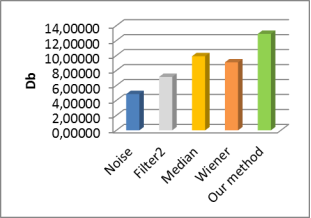
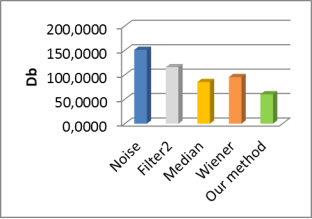
Fig. 2. Average PRSN and RMSE
4 Experimental results of the image clarity enhancement based on frequency filtering
The basis for linear filtration in the frequency and spatial domains is the convolution theorem. In fact, the basic idea of filtering in the frequency domain is to choose a filter transfer function that operates ![]() in a specific way.
in a specific way.
A filter having a transfer function that is multiplied by the centered function ![]() weakens the high-frequency components
weakens the high-frequency components ![]() , and leaves the low-frequency components relatively unchanged and is called a low-pass filter.
, and leaves the low-frequency components relatively unchanged and is called a low-pass filter.
Images and their transformations are automatically considered periodic if the filtering is implemented on the basis of a two-dimensional Fourier transform.
When convolving periodic functions, interference effects between adjacent periods occur if these periods are located close to the length of the nonzero parts of the functions. Such an interference is usually called a return error or an overlap error, which can be suppressed by adding zeros to the functions.
For this experiment a dark image from surveillance camera is taken. For clarity enhancement of the image, we use the improved realization of a frequency filter.
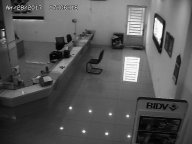
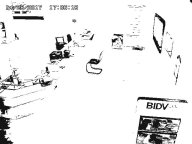
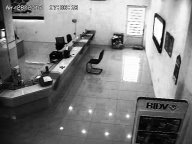
Fig. 3. Original image, an intermediate image with the improved contrast, the enhanced image
The proposed method allows not only to improve clarity of the image, but also to significantly change its brightness and contrast. In purpose to demonstrate the performance of the realized filter, the histograms of the source image and the result image are shown in Fig. 4.
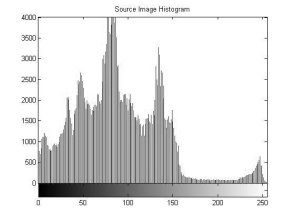
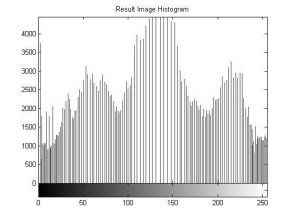
Fig. 4. Source image histogram and Result image histogram
Estimation of the dispersion of brightness of the source image shows the value equal to 0.30. The contrast of the result image is increased by 0.41. The range lays the values [0,1]. The value 0 corresponds to a monochrome image, 1 to the maximum contrast. Thus the method brings the original dark and not clear image to the optimal bright and contrast one.
Conclusion
For noise removing we have implemented the median filter in a different way, so the filter works with the edges of the image as good as with its not border parts. The suggested algorithms are implemented by using Matlab. We use the RMSE and PSNR to evaluate the enhancement performance and then compare the calculated results with the results of such filters as Median, Wiener and filter2, removing Salt & Pepper noise, Poisson and Speckle noises. Lastly, the average value is calculated, which has shown PSNR is equal to 12.89957, and it’s way higher than PSNR of the considered filters. RMSE in its turn is equal to 60.0123.
For the image clarity enhancement we have implemented an improved algorithm based on the frequency filtering. This method helps to improve brightness and contrast, not speaking of the clarity of the image. In purpose to demonstrate the performance of the realized filter, the histograms of the source and the result images have been shown. Estimation of the dispersion of brightness which is contrast of the source image shows the value equal to 0.30. The contrast of the result image is increased by 0.41. Thus the results show that the proposed method is processing the image in optimal way and performs satisfying work.
References:
1. Meshram S A, Malviya A V. Traffic surveillance by counting and classification of vehicles from video using image processing. International Journal of Advance Research in Computer Science and Management Studies, 1(6), November 2013.
2. Rybalka R, Honcharov K. Method for pre-processing of level crossing image. Transport problems, 10(1), 2015.
3. Xu X, Liu W, Li L. Low resolution face recognition in surveillance systems. Journal of Computer and Communications, 2, 2014.
4. Jerian M, Paolino S et al. A forensic image processing environment for investigation of surveillance video. Forensic Science International, 167, 2007.
5. Asirvadam V J, Altahir A A, Sebastian P. Event triggering with crisp set using images of surveillance systems. IJVIPNS-IJENS, 10(02), 2010.
6. Zhivotchenko O V, Yaroshenko N A. Video surveillance image processing with for determining the vehicle sign. ICS and CM, 4(4), 2012.
7. Parrolli S. A Non Local SAR image denosing algorithm on LLMMSE Wavelet Shrinakge. IEEE Transactions On Geoscience And Remote Sensing, vol. 50, No. 2, February 2012.
8. Jaun C., Jimenez-Munoz, Jose A. Sabrino. Surface emissivity retrival from airborne hyper spectral Scanner data; insights on atmospheric correction and noise removal. IEEE Geoscience And Remote Sensing Letters, March 2012, vol. 9, No. 2.
9. Fralenko V P. Analysis of spectrographic textures of Earth remote sensing data. Artificial intelligence and decision making, 2010.
10. J Sivakumar, Dr. K Thangavel, P Saravanan. Computed Radiography Skull Image Enhancement using Weiner Filter. IEEE, ID:978–1-4673–10390/12, June 2012.







